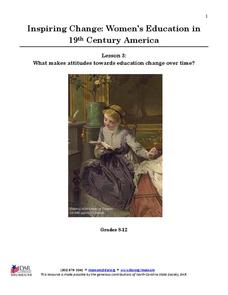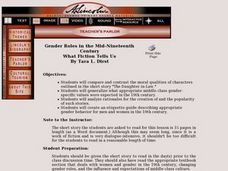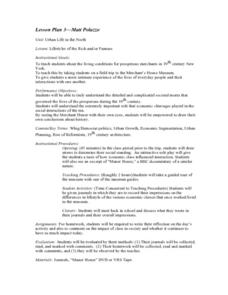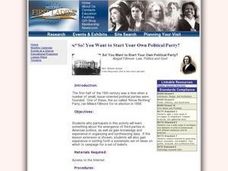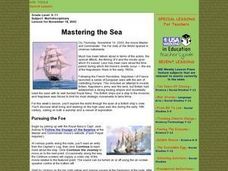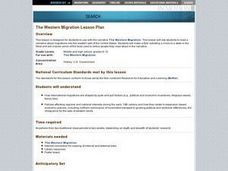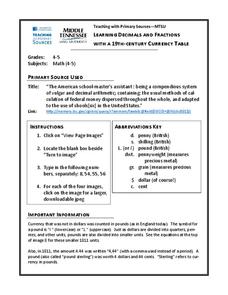C3 Teachers
Women’s Rights: What Does It Mean to Be Equal?
A guided-inquiry lesson asks seventh graders to research the compelling question, "What does it mean to be equal?" Guided by three supporting questions, researchers complete three formative performance tasks and gather evidence from...
National Society Daughters of the American Revolution
Lesson 3: What Makes Attitudes Towards Education Change over Time?
The struggle for women's rights is not unique to this generation, or even to the 20th century. Class members explore the conflicting opinions of Alexander Graham Bell and his wife, Mabel Hubbard Bell, regarding women's pursuits of higher...
Daughters of the American Revolution
Lesson 1: How Do Society’s Expectations Influence Education?
The history of women's education can be traced back to the delicate stitching of student samplers from the 19th century. Modern-day pupils examine and analyze four primary sources, three of which are images of embroidered samplers, which...
Daughters of the American Revolution
Lesson 2: How Do We Determine the Value of Education?
Have women always had the same educational opportunities as their male counterparts? Young historians read an 1819 essay by Emma Willard on the state of female education in the 19th century before discussing their views regarding women's...
Curated OER
If You Were a Pioneer on the Oregon Trail
Young scholars examine what it was like to travel west on the Oregon Trail. They develop a list of questions about the trip, explore various websites, and create a story about the experiences of a 19th century family travelling on the...
Curated OER
Jeffersonianism at the Bar
Eleventh graders participate in a political roundtable discussion. In this Jeffersonianism lesson, 11th graders role play individuals from the 19th century and discuss issues of the Federalist period.
National Endowment for the Humanities
The 1828 Campaign of Andrew Jackson: Changes in Voting Participation
Students give examples to indicate how voting participation changed in the first half of the 19th century, and make connections between changes in voting participation and the results of the election of 1828.
National Endowment for the Humanities
The 1828 Campaign of Andrew Jackson: Expansion of the Voting Base
Students give examples to indicate how the franchise was extended and limited in the first half of the 19th century, and cite some differences in the newly enfranchised population that could affect the way they would vote.
Curated OER
Nellie Bly's Newspaper Club: Introducing the Art of Writing
Students use video and the Internet to research the life of Nellie Bly, a famous female reporter from the 19th century. They research a writer and present their information to the class in the style of a news reporter.
Curated OER
A House Dividing: The Growing Crisis of Sectionalism in Antebellum America
Students explore the debates over American slavery and the power of the American federal government for the first half of the 19th century and how the regional economies and political events produced a widening split between the states.
Curated OER
The Art and Science of Impressionist Color
Discover Impressionist painting as students investigate the 19th century combinations of colors characteristically used. Students experiment with their own paintings, utilizing primary and secondary colors.
ReadWriteThink
Beyond the Story: A Dickens of a Party
It's time to party like it's 1899! Incorporate a research-based celebration of the Victorian Era into your unit on A Christmas Carol by Charles Dickens. After learners read the novella or view a production of the play, they craft a...
Curated OER
Gender Roles in the Mid-Nineteenth CenturyWhat Fiction Tells Us
Learners examine 19th century gender roles. In this gender roles lesson plan, students read "The Daughter-in-Law" and discuss their impressions of etiquette and gender roles in the 19th century. Learners write etiquette guides that...
Curated OER
Lifestyles of the Rich and/or Famous
Students explore and analyze the detailed, yet complicated profiles that society placed on the lives of the prosperous as well as those with economic disadvantages in 19th century New York. In addition, by seeing the Merchant House...
Curated OER
Moby-Dick
High schoolers take on the persona of a sailor or a captain of a whaling vessel in New England in the 1800s and write five journal entries as that person. For this Moby Dick lesson, students research the whaling industry in 19th century...
National First Ladies' Library
So! You Want to Start Your Own Political Party?
Young scholars examine the emergence of third parties in American politics during the first half of the 19th century. Working in groups, they research a Third Party and determine why the party was founded as well as who were instrumental...
Curated OER
This Land is Ours
Students research and present their findings of the Native American's forced removal in the 19th century. In this Native American lesson plan, students read passages, write and reflect, and look on the internet for evidence of the Native...
Curated OER
Mastering the Sea
Young scholars investigate what life was like on early 19th century ships. They participate in a Webquest, explore the website for the movie, 'Master and Commander,' watch movie excerpts, take an interactive tour of a ship, and answer...
Curated OER
The Western Migration Lesson Plan
Students examine the western migration in the United States in the early 19th century and identify the factors that caused the migration as well as how government adapted to meet the needs of an expanding country.
Curated OER
Prairie Activity: Prairie Quilt
Students investigate prairie life in the 19th century. They research quilts and prairie images online, take a photo of an object related to prairie life, transfer the image onto fabric, and create a class quilt.
Curated OER
Decimals and Fractions
Students learn about using decimals and fractions by referring to a 19th century currency table. In this decimals and fractions lesson plan, students discuss converting pounds to coins and how they relate to fractions and decimals.
Curated OER
The Golden Spike
Students investigate modern transportation in the 19th century by examining artifacts. For this U.S. history lesson, students read the story Joseph's Railroad Dreams, and discuss the Golden Spike used in the first transcontinental...
Curated OER
19th Century Women's Suffrage - Sheltered Activities
Students reenact The USA v. Susan B. Anthony and discuss women's suffrage and the 19th Amendment.
Curated OER
In the Footprints of Lewis and Clark: 19th Century Artists -- Depictions of Native Americans
Eighth graders read excerpts of "Undaunted Courage" by Stephen Ambrose. As a class, they view slides of artwork from the time period of westward expansion and Native Americans, write their reactions and share them with the class. To...
Other popular searches
- 19th Century Inventions
- 19th Century Immigration
- 19th Century America
- 19th Century Child Labor
- 19th Century Farming
- Women's Rights 19th Century
- 19th Century Music
- 19th Century Inventors
- 19th Century Clothing
- 19th Century u.s.a
- 19th Century Immigration
- Late 19th Century America



